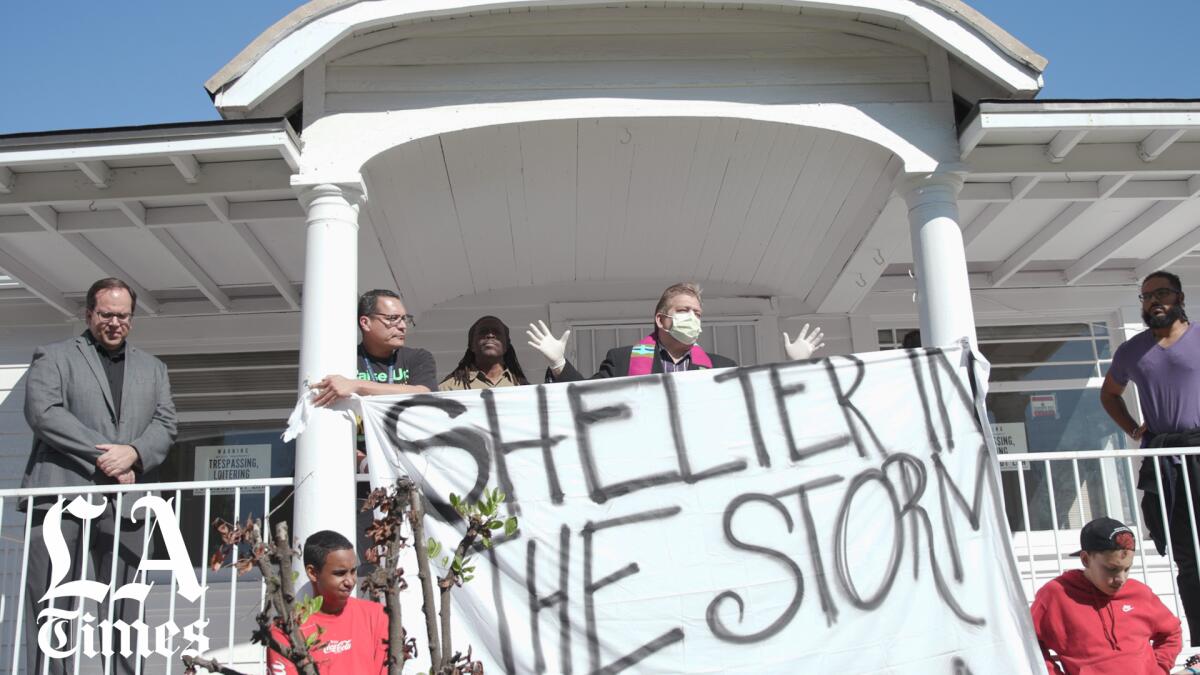Caltrans is sitting on vacant houses during a pandemic? Put homeless families in them immediately

- Share via
For years, dozens of perfectly good houses in El Sereno and nearby areas have sat empty, even as California’s housing shortage has grown more and more dire.
The houses are owned by Caltrans, the state’s transportation agency, which began acquiring them in the 1950s and 1960s to make way for the 710 Freeway extension. But the proposal to “close the gap” — by building the final 4.5-mile stretch to connect the 710 to the 210 Freeway — was finally and definitively killed in 2017. That left more than 400 properties, including houses, apartments, commercial buildings and vacant lots surplus. Some are occupied by tenants, but 87 single-family homes are vacant.
Last week, a group of families that are homeless or at risk of becoming so decided to start moving into some of those empty houses. As of Friday, the group, which calls itself Reclaiming Our Homes, had taken over 12 houses. The occupations are both a plea for help for struggling families and a protest against the state’s failure to move faster to solve the housing crisis — which is obviously an even greater concern at a time when Gov. Gavin Newsom has ordered people to stay at home to help slow the spread of the novel coronavirus.
That order is meaningless for families who don’t have a home, who are living in an RV or couch surfing with family and friends. There’s no way to shelter in place if you don’t have reliable shelter.
Are the “reclaimers” breaking the law? Of course. They’re trespassing on state-owned land and essentially claiming public property as their own. There’s no utility service in many of the houses. Neighbors have warned of black mold and pest infestations in some of the houses, which may not even be safe for habitation. Squatting is not a sustainable solution.
But activists saw their opportunity to push Caltrans to act, and they took it. It was bad enough that the state allowed houses to sit vacant for years during a growing homelessness and housing affordability crisis. Now, in the middle of a public health emergency, it’s unconscionable to allow so many empty, decaying homes to sit idle.
Caltrans had long been criticized for being an absentee landlord, with some properties boarded up and covered in graffiti. Neighbors and community groups repeatedly called on the agency to hurry up and sell the properties. But the process has been sluggish at best. The agency has sold 10 properties since 2016; nine were bought by tenants at below-market prices. There are still dozens of vacant homes that could be sold or rented.
This is part of a larger struggle underway in California to make sure housing doesn’t sit vacant when there is a critical shortage. A group of homeless mothers called Moms 4 Housing drew national attention when they took over a house in Oakland that was owned by a company that buys, renovates and sells properties for profit. They were evicted in January, but after the governor and Oakland leaders got involved, the owner agreed to sell the house to a nonprofit and the mothers were expected to move in permanently.
Their protest also inspired several proposals in the state Legislature, including Senate Bill 1079 by Sen. Nancy Skinner (D-Berkeley) that would give cities the power to fine corporations that let their properties sit vacant for more than 90 days, or to seize the properties and use them for affordable housing.
There are legitimate debates to be had over how much the government should infringe on private property rights during a housing shortage. But the protesters in El Sereno have targeted a much easier-to-solve problem: The state cannot allow its own vacant houses or other public properties to sit unused and crumbling in a housing and public health emergency.
More to Read
A cure for the common opinion
Get thought-provoking perspectives with our weekly newsletter.
You may occasionally receive promotional content from the Los Angeles Times.









